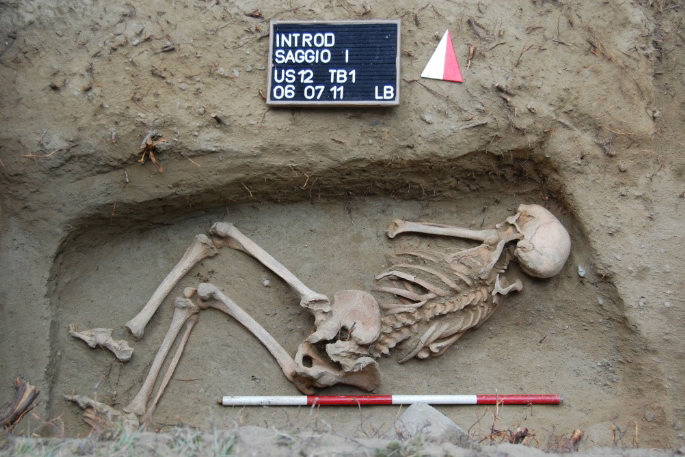Archaeologists surveying a site before construction of an addition to the kindergarten in the tiny Alpine village of Introd, Val d’Aosta, have unearthed the well-preserved skeleton of a woman dating to around 3,000 B.C. That’s approximately the same age as Otzi, the famous iceman found in a melting glacier in the Tyrolean Alps, and that’s enough to get her an “Otzi’s girlfriend” monicker even though their final resting places are on separate sides of the Alps, about 300 miles of rough mountain terrain apart.
The skeleton hasn’t been carbon dated yet, but the stratigraphy — analysis of the layers of ground — and the position in which she was found suggest she died in the third millennium B.C. She was found lying on her right side with her head facing west and does not appear to have been moved or messed with at all since burial. There are no grave goods, however. The team will continue excavating the burial to see if they can find any, and soil samples have been taken to see if there were plants interred with her that have long since decayed.
The remains were immediately shipped to the laboratory where they will be examined for osteological evidence of the lady’s history, her age at death, her diet, any diseases or injuries. Forensic archaeologists are particularly excited to compare the isotope analysis of her teeth to Otzi’s. Even though they weren’t exactly neighbors, they lived close enough to each other in time and space that scientists hope there is much to be learned in the comparison of their diets and movements.
According to Kristina Killgrove, a biological anthropologist at the University of North Carolina, further research into the woman’s diet would be particularly interesting.
“Little direct evidence of human diet has been found from this time period. Ötzi’s preservation, of course, provides unparalleled information about his diet, but it would be fascinating to see stable isotope analysis carried out on this skeleton, who lived around the same time and also died in the Alps,” Killgrove told Discovery News.
She believes that the “Lady of Introd” likely tapped different food resources since several hundred miles separated her from Ötzi the Iceman.
“In particular, we still know little about what grains people ate at this time, so the Lady of Introd could provide direct evidence of a diet composed of wheat, barley, or millet,” Killgrove said.
The children at the kindergarten where she was found will get to pick her name.
